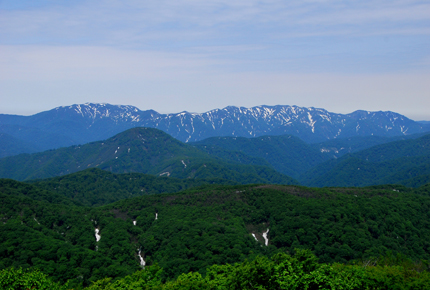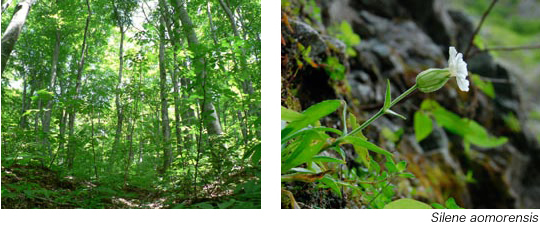- Ministry of the Environment>Nature & Parks>
- World Natural Heritage in Japan>
- Shirakami-Sanchi>
- Outstanding Universal Value
Outstanding Universal Value

- The largest primeval beech forest in East Asia which features rich biodiversity
A Surviving Primeval Forest
Shirakami-Sanchi contains the largest primeval beech forest in East Asia, having been untouched by human development. Beech forests were once distributed in the area around the Arctic region when the Earth was warmer than it is now. They were home to a diverse array of vegetation including Siebold's beech, Silene aomorensis, and Hylotelephium ussuriense var. tsugaruense, which are said to be surviving remnants (relicts) from the ice age. During the ice age, the beech forests moved south in response to the cooling of the climate. In many parts of the world, including Europe, shrubs and herbaceous plants could not migrate southwards because they were hindered by mountains stretching from east to west. Only beech trees migrated south and established themselves in new areas, but this simplified the vegetation in beech forests. In Japan, however, there were no mountains to prevent the southern distribution of beech forests, so they migrated southwards, largely maintaining the species composition. As a result, the Shirakami-Sanchi has preserved a distinctive beech forest similar to those that existed around the Arctic region approximately 30 million years ago.

A Forest Museum
During the winter, Shirekami-Sanchi receives the damp air from the Sea of Japan, making the region extremely snowy by global standards. Vegetation that is reflective of the heavily snow-laden environments can be seen on the ground in the beech forests, as is represented by Sasa kurilensis. More than 540 species of plants grow here, including Silene aomorensis endemic to this region. Shirakami-Sanchi is also home to a diverse array of animals, which includes 35 species of mammals, 94 species of birds, and approximately 2,200 species of insects. These include rare birds like golden eagles and black woodpeckers, as well as Japanese serows and Japanese black bears. The beech forest of Shirakami-Sanchi can be described as a museum of forest ecosystems, based primarily on Siebold’s beech, a species endemic to Japan.








